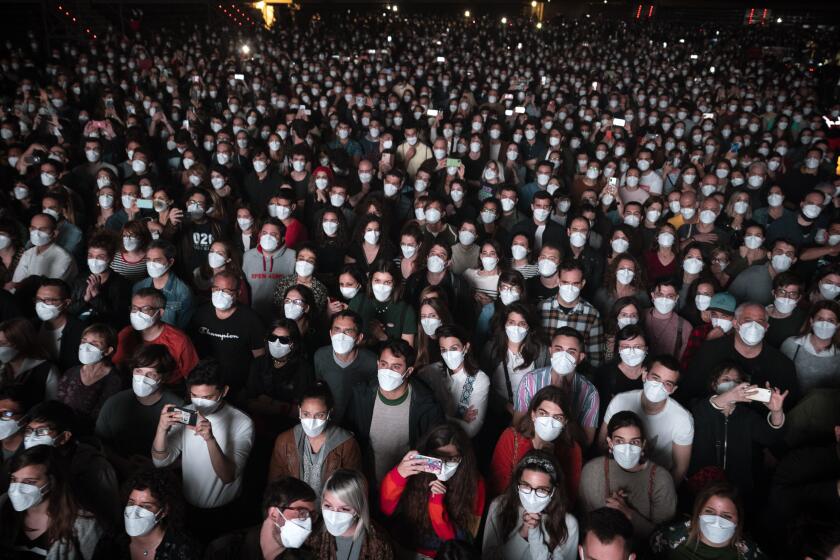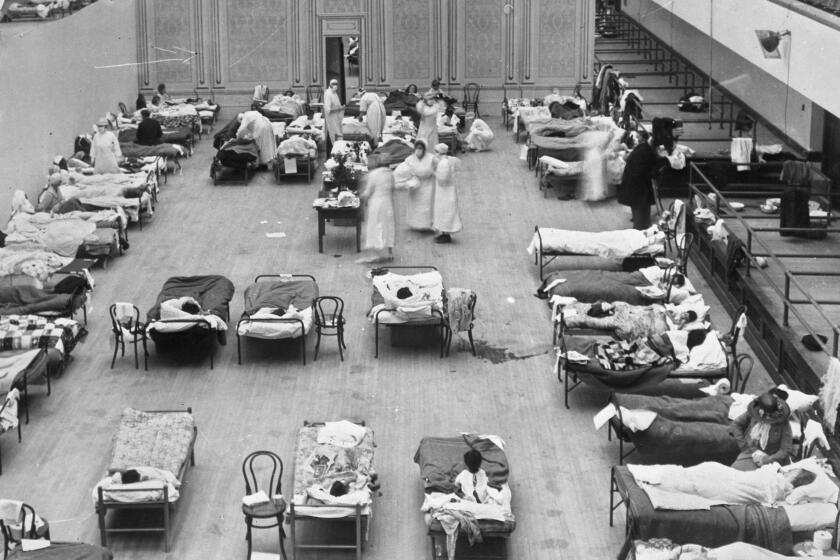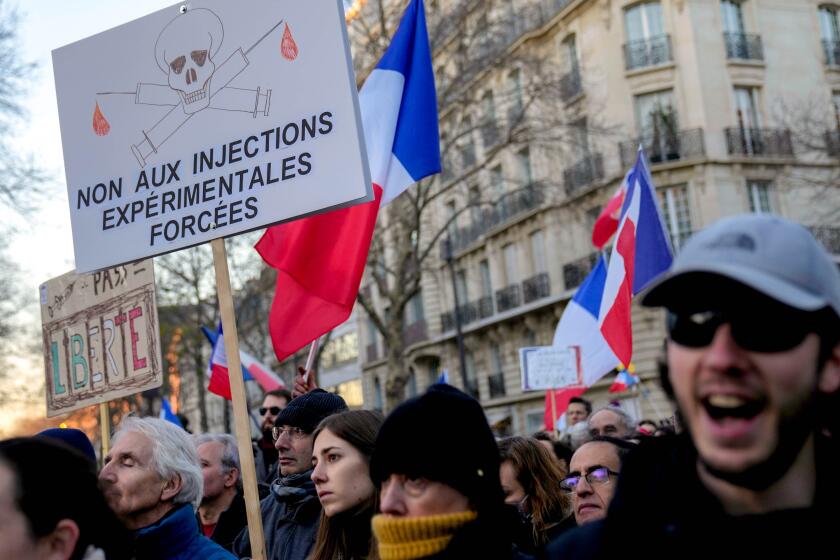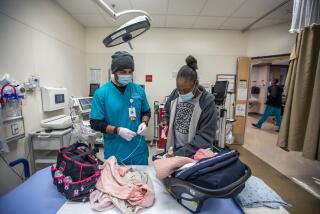More countries in Europe, recently the pandemic’s epicenter, ease COVID restrictions
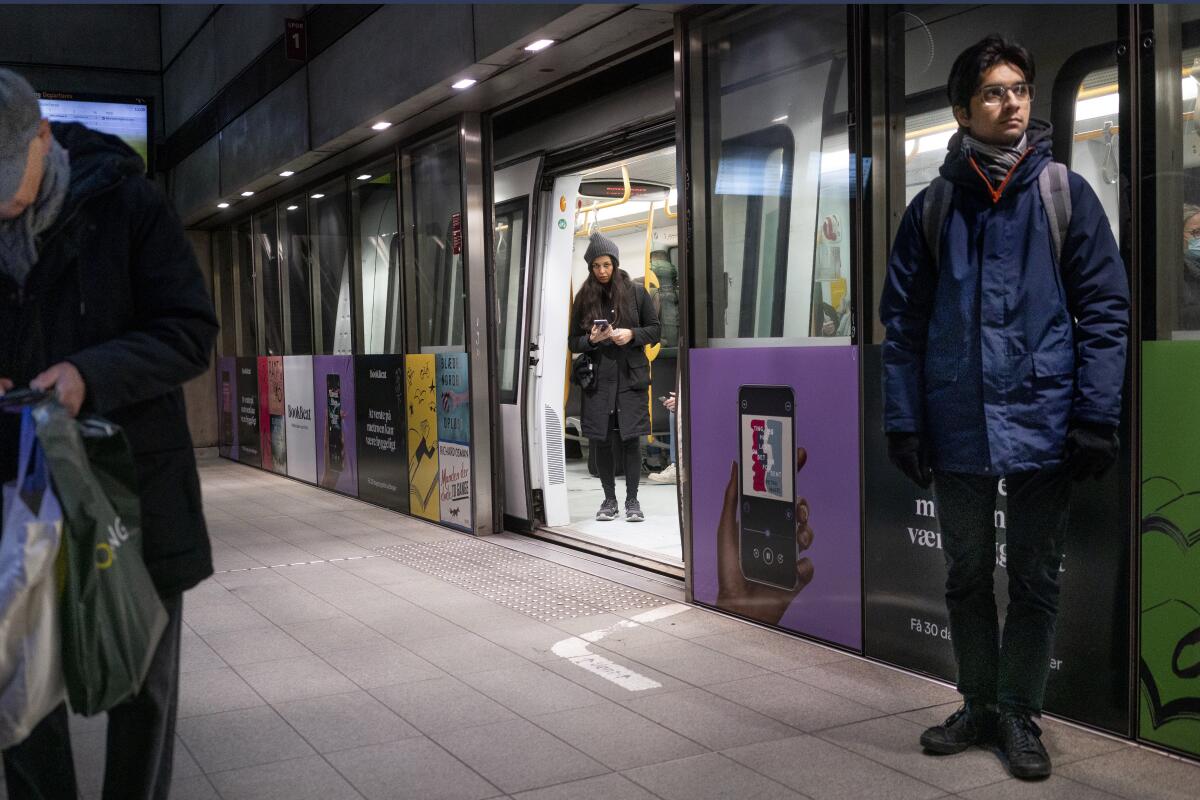
- Share via
GENEVA — Late-night disco partying. Elbow-to-elbow seating in movie theaters. Baring of faces in public, especially in Europe and North America.
Bit by bit, many countries that have been hard-hit by the coronavirus are opening up and easing their tough, and often unpopular, restrictive measures aimed at fighting COVID-19 even as the Omicron variant — deemed highly contagious but less severe — has caused cases to skyrocket.
The early moves to relax such restrictions have the makings of a new turning point in a 2-year-old pandemic that has been full of them.
Omicron has fueled more cases — 90 million — in the world over the last 10 weeks than during all of 2020, the outbreak’s first full year, the World Health Organization says. The WHO acknowledges that some countries can judiciously consider easing the rules if they boast high immunity rates, strong healthcare systems and favorable epidemiological curves.
Omicron is less likely to cause severe illness than the previous Delta variant, according to studies. But it spreads even more easily than other coronavirus strains and has already become dominant in many countries. It also more easily infects those who have been vaccinated or had previously been infected by prior versions of the coronavirus.
But the United Nations health agency, ever leery about how a virus still spreading widely might evolve, warned about underestimating Omicron.
Many European countries overwhelmed by the record number of Omicron cases are already giving up on massive testing and cutting quarantine times.
“We are concerned that a narrative has taken hold in some countries that because of vaccines — and because of Omicron’s high transmissibility and lower severity — preventing transmission is no longer possible and no longer necessary,” WHO chief Tedros Adhanom Gheybreysus said at a briefing on the pandemic Tuesday. “Nothing could be further from the truth.”
His emergencies chief, Dr. Michael Ryan, said some countries could justifiably begin easing restrictions but warned about a rush to the exits and advised that countries assess their own situations. He cautioned that “political pressure will result in people in some countries opening prematurely — and that will result in unnecessary transmission, unnecessary severe disease and unnecessary death.”
The WHO has long spoken of a lag time between when cases are reported and their effect on the death toll. Late Tuesday, it said new reported cases worldwide from Jan. 24 to Jan. 30 were similar to the level of the previous week, but the number of new deaths increased by 9%, to more than 59,000. More than 370 million cases and over 5.6 million deaths linked to the coronavirus have been reported worldwide.
The most pronounced pullbacks are popping up in Europe, for many months the world’s epicenter of the pandemic, as well as in South Africa — where Omicron was first announced publicly — and the U.S., which has tallied both the most cases and deaths from COVID-19 of any single country.
A leading World Health Organization official says the worst of the COVID-19 pandemic — including deaths, hospitalizations and lockdowns — could be over this year if huge inequities in vaccinations and medicines are addressed quickly.
Britain, France, Ireland, the Netherlands and several Nordic countries have taken steps to end or ease their COVID-19 restrictions.
Last week, England ended almost all domestic restrictions: Masks aren’t required in public, vaccine passes are no longer needed to get into events or other public venues and the work-from-home order has been lifted. One lingering requirement: Those who test positive still have to self-isolate.
On Tuesday, Norway lifted its ban on serving alcohol after 11 p.m. and its cap of no more than 10 people at private gatherings. Travelers arriving at the border no longer will be required to take a coronavirus test before entry. People can sit elbow-to-elbow again at events with fixed seating, and sports events can take place as they did in pre-pandemic times.
“Now it’s time for us to take back our everyday life,” Norwegian Health Minister Ingvild Kjerkol said Tuesday. “Tonight, we scrap most measures so we can be closer to living a normal life.”
Our species lived through the Spanish flu, polio, ebola, SARS, and swine flu. How have humans gotten themselves out of pandemics in the past? And how might we get out of this one?
Just as some libertarians, vaccine opponents and others ignored government restrictions and mandates, many people may resist reopening. Some may stick to wearing masks even if not required, or avoid crowded events; widespread handshakes and cheek-kisses may have to wait.
As throughout the pandemic, many countries are going their own way. Italy has tightened its health pass requirements during the Omicron surge. From Monday, its government requires at least a negative test within the previous 48 hours to enter banks and post offices, and anyone over 50 who hasn’t been vaccinated risks a 100-euro ($113) fine.
Austria, which was the first European country to impose a vaccine mandate, is planning to loosen some COVID-19 restrictions this month, such as allowing restaurants to stay open later. Greece has ordered fines for people 60 and older who refuse to get vaccinated.
In Germany, where infections are still hitting daily records and officials are still concerned about a large number of unvaccinated older people, restrictions like curbs on private gatherings and requirements for people to show proof of vaccination or recovery to enter nonessential shops remain in place. The country’s leaders plan to review the situation Feb. 16.
From mandating COVID-19 shots for everyone over 50 to excluding the uninoculated from more venues, European countries get tougher on the unvaccinated.
“I think that the moment we have the feeling that we can loosen [restrictions] responsibly, federal and state governments will take that step,” German government spokesman Steffen Hebestreit said Monday. “But at the moment, it is still a bit premature.”
Other continents are being even more cautious. Some of the world’s highest vaccination rates are found in Asia — which is no stranger to earlier viral outbreaks, such as SARS and MERS — and its leaders are holding to stricter lockdown measures or even tightening them, for now.
The Pacific Rim nation of Tonga was entering a lockdown Wednesday evening after finding coronavirus infections in two port workers helping to distribute aid after a volcanic eruption and tsunami. That came against fears that the fallout from the natural disaster last month could spark a second disaster by bringing the pandemic to a nation that had been coronavirus-free.
On the eve of hosting the Winter Olympics, China is sticking to its formal zero-tolerance policy even as 85% of its population is fully vaccinated, according to Our World in Data figures. Beijing imposes strict lockdowns and quarantines quickly when any cases are detected, and continues to require people to wear masks on public transportation and show “green” status on a health app to enter most restaurants and stores.
Thailand, where 69% of the population is fully vaccinated, continues to require masks in public and enforces social distancing, as well as other restrictions.
Singapore, which boasts Asia’s highest rate of vaccination, with 87% of the eligible population having received at least two shots, is maintaining its restrictions even as it heads along a “transition journey to a COVID-19 resilient nation,” which began in August. The city-state reserves the right to relax or tighten rules as conditions warrant.
With nearly 80% of its people fully vaccinated, Japan has resisted mandatory restrictions but continues exhorting the public to wear masks and observe social-distancing practices and requesting restaurants to shorten opening hours. Cambodia, with 81% of its people vaccinated, has dropped restrictions on restaurants and other businesses but still requires masks in public and encourages social distancing.
In the United States, local leaders have served up a hodgepodge of responses. Denver announced Monday an upcoming end to its mask mandate for businesses and public spaces, while keeping them for city schools and public transportation. A similar move in New York state, where Omicron cases peaked and then plunged since late December, is tied up in the courts.
More to Read
Sign up for Essential California
The most important California stories and recommendations in your inbox every morning.
You may occasionally receive promotional content from the Los Angeles Times.
